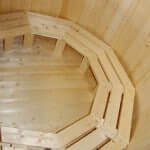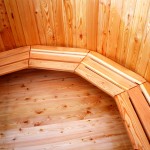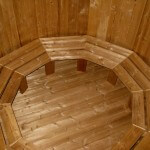spruce, larch, thermowood
Spruce

Spruce grows in whole Europe. spruce, larch, thermowood
Spruce wood from Scandinavia is called Nordic Spruce in the trade.
Spruce wood coming from northern growing areas is the most upmarket spruce wood because it has a finer wavy grain. Spruce wood is softer and of medium-weight. Spruce wood is not a long-lasting natural wood: i.e. it is not very weatherproof unless it is kept up or shielded.
Spruce is an important timber, the wood being used for general construction and paper making. The leaves are used to make spruce beer.
With its strength, flexibility, and natural good looks, spruce is a great choice for wood siding. It also takes very well to wood treatments.
The wood is white, light, and soft; it is used in construction, in paper production, and for making musical instruments. The wood yields tar, pitch, turpentine, rosin, wood vinegar, and tanning substances. Spruce trees are usually cultivated in parks and planted in forest zones and along railroads and roadways.
Spruce strengths:
- It doesn’t conduct heat and it doesn’t leak resin.
- It is one of the most sturdy types of wood.
- Versatile, easy to work with and treat
- Strong, stiff and tough
- Readily available
Spruce weaknesses:
- Susceptible to rot
- Must be regularly treated and sealed
Siberian Larch
 Larch trees grow throughout Europe and belong to the less deciduous conifer trees.
Larch trees grow throughout Europe and belong to the less deciduous conifer trees.
Larch wood belongs to the heaviest and resilient conifer wood available on the market.
Larch wood is frequently used for outdoor purposes due to its hardness. It is also used in the ship- and boat crafting area. It is very decorative and reaches a very high hardness level. The natural resistence to the weather distinguishes larch wood from all other domestic conifer woods.
Larch is a wood valued for its tough, waterproof and durable qualities. Larch is a highly ecological, people-friendly and warm building material. It is widely used in Europe in the construction of terraces and as a covering material for the facades of buildings. It is virtually irreplaceable in situations where chemical finishing of wood is not permitted but its durability in all weather conditions must be guaranteed. The timber is resistant to rot when in contact with the ground, and is suitable for indoor and outdoor building as a replacement for creosoted material. spruce, larch, thermowood
Siberian larch becomes more and more requested due to environmental aspects. Because of its density and richness of the tar and resin Siberian larch is very durable material for outdoor use, even without additional finishing. Siberian Larch is a strong and dense timber. Thanks to its high gum content, Larch can be used in its natural form. The gum is distributed very evenly between the fibres of the wood, which has an antiseptic effect, protecting it against moisture and insects. Over time its resilience and density will only grow. The timber is naturally very durable and requires no harmful chemicals to preserve it. Larch is a perfect alternative to impregnated wood for outdoor use.
Larch is also one of the best solutions when there are strict requirements regarding formaldehydes, as in products designed for children, for example wooden playground equipment.
ThermoWood

Thermo-processed wood is darker than natural wood, more weatherproof and more resistant to rot. Its insulation qualities are better, it suffers from less moisture deformation and is more stable. The equilibrium moisture is up to 50% less than natural wood, which makes thermo-processed wood a better option for use in outdoor conditions.
Thermo-timber is wood having been modified concerning its qualities by means of thermical processing (high-temparature processing). The qualities desired are set by high temperatures (170 up to 230 °C) without the application of any excipients. The process of kilning the timber is environmentally friendly. Thermowood is made through a chemical-free process using heat vapour and steam.
Wood becomes more resistant through high temperature and is a real alternative to tropical timber.
Thermically modified timber is the output after thermical treatment. This is a process enhancing the whole wood area enabling to use the timber for specific purposes.
This process serves for making timber resistent against rottenness. This opens the possibility to also use domestic wood for outdoor purposes. This process avoids that fungal infestation damages appear on the timber after a short time. The timber does not store water so easily and the typical consequences such as bulging, breaking or rottenness are reduced substantially. We only use thermo-wood of high quality which has been treated on the basis of the Finnish process.
The Benefits of ThermoWood
- Moistness is reduced around 10–60%
- More resistant against rottenness and mouldiness
- The timber is getting darker and these dark shades are not UV-resistent
- Enhanced resistance to weather
- The timber is much lighter than before
- Resins are removed completely
- The pressure resistance is levelled up to ca. 58 %
- pH-value is lowered
- Deformation through clamminess is reduced up to 90 %
- Isolating capability is improved
- Enhanced design- and surface capability
- Consistent colour throughout the wood
- Improved durability against decay
- Improved dimensional stability
- Preservative-free
- Hygienic
